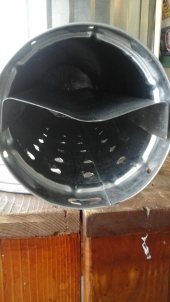I have heard it asserted by someone of rank in the
RMH community (I cannot remember who) that in the burn chamber, the hottest gasses will rise to the top. This made a lot of sense, and was concerning to me because I am (in my first build) planning to use a tall (9 inch) and narrow (5 inch) burn chamber. I envisioned great difficulty in getting a proper mixing of gasses with this tendency for the hot ones to float way up to the top.
The purpose for my narrow burn chamber is that it allows my 8 inch system to shoot gasses into the right side of its 10 inch octagonal heat riser, producing a vortex without any complicated steel contraptions like I have seen others using. I have just completed a successful weekend of outdoor testing, and discovered that the mix is excellent without any tinkering.
As the stove was getting up to temperature, a film of black soot developed on the interior of the insulative firebrick riser. By looking down the riser, I could see a uniform stream of flame coming out of the whole height of the burn chamber. As the stove continued to heat, the soot began to burn off, starting at the bottom of the
feed tube, and gradually progressing to the top of the riser. When this clean portion emerged from the burn chamber into the riser, it did so first at the lower-most point-- meaning that the bottom, not the top, of the heat riser is the hottest!
In hindsight, this makes a lot of sense. Embers from the feed tube fall out into the floor of the burn chamber, heating it and streaming off hot gasses along the bottom. Also, air intake is sucked in primarily along the path of least resistance at the top. This all means that the insulation below, not above the burn chamber is most important, and that mixing is inherent in the design, as cool intake air tries to swap places with hot exhaust on the bottom.
-Phil



























 May be you could add a neutral vane.
May be you could add a neutral vane. 













